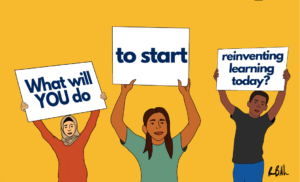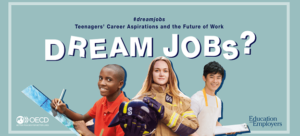Motivating Young People to Pursue the Professions of the Future

By: Mark C. Perna
The future workplace is fascinating to consider. Things are changing more rapidly than ever, with automation, AI, and globalization affecting an increasing number of professions. The skills gap is a significant concern, as the mismatch between the skills employers need and the skills that prospective workers actually possess is expanding. Only one thing is certain: today’s young people will be entering an economy and workforce much different than what older generations have experienced.
But in the midst of all the studies, reports, policy questions, and initiatives to solve these challenges, the young people who are to fill the jobs of the future can be strangely marginalized. These workers aren’t pawns to be moved here and there on the employment chessboard as policymakers and think tanks dictate. The Future of Work is a future that will be created by them—not by those of us in the older generations. We cannot lose sight of the human factor and how the traits of the next generation will motivate them to perform to their full potential in the workplace of the future.
The Why Generation
The Why Generation is my collective term for Generations Y and Z, the millennials and the generation immediately following. This title is based on their two most prominent traits: inquisitiveness and innovation. These deeply interrelated qualities define these generations in a way that gives us fresh insight into who they are and what makes them tick.
Simply put, the Why Generation is always asking why. And it’s a serious question; in fact, the importance of answering it is the reason I titled my book Answering Why. Their inquisitive nature leads them to ask, why do we do things this way? Why is this needed? Why can’t we make it better?
Once they have that information, they innovate with it. They use it as a springboard to come up with new strategies and solutions for age-old challenges. They’re constantly looking for ways to do things more quickly without sacrificing quality. They delight in unveiling solutions that combine speed with enhanced quality.
To older generations, the constant question of why can come across as insubordination or a challenge to authority, but in general, this isn’t the meaning that younger workers intend to convey. Young people in the workforce today ask why because they truly want to know. They want to know because the answer will inform their own contribution to the process and end result. Behind every question is a quest to see the big picture, formulate a more efficient and effective process, and deliver an improved outcome. They’ve been reared to believe they are unique, special, and important, and they carry this mindset into their careers. That’s why they believe they have something new to offer that will improve the ultimate result. And they do.
In a world where it’s normal to decry the degeneracy, entitlement, laziness, etc. of the younger generations, we can choose to look at them in a completely different way. Having coached educational and business organizations for more than 20 years on how to recruit, retain, and engage the younger generations to perform at a higher level, I don’t find the popular negative caricature to be accurate. In fact, the opposite is true.
I see young people discovering their career passion and moving heaven and earth to reach it. I see educators enthusiastically praising the impressive efforts of their students to master their subject and use it in their future careers. And I see businesses starting to view younger workers as tremendous assets and resources rather than liabilities and challenges to be navigated.
Motivating the Next Generation
Because they have to see the why, young people today are motivated a little differently from older generations.
Young people have to see a bigger why behind the company vision than just shareholder returns and making money. Yes, they have high expectations for salary, advancement, vacation time, and flexibility. But their biggest expectation in the workplace is a career that is meaningful and achieves something positive in the world. The Why Generation wants the hours they spend working to deliver more significance than just the ability to pay their bills. They want their work to make the world a better place in some way.
In general, older generations viewed their careers as a means to an end: the paycheck. They were largely content with a good salary and job security, and those things still matter—just not as much. Because the big picture is such a paramount concern to the Why Generation, purpose is the single most important motivating factor in their decisions. As a socially and environmentally conscious generational cohort, they’re passionate about making the world a better place. And they want to invest their careers at organizations that share that vision in some form. Companies that align with the Why Generation’s personal values will attract younger workers in greater numbers.
Retaining the best talent in the younger workforce is just as important as recruiting it. According to the 2018 Deloitte Millennial Survey, 43% of millennials expect to leave their current positions within two years. That alarming number jumps to 61% among Generation Z workers. In addition, a recent Gallup poll reports that just 34% of workers feel engaged in their current jobs. Though this ties the highest number on record since 2000, we are still left with 66% of American workers who are “not engaged” or worse, “actively disengaged.”
If a firm does not have a vision and culture focused on doing something positive for the community, younger employees are much less likely to want to invest their time, energy, and career there. And if they do work there, they are much more likely to jump ship and find a new position at the earliest opportunity.
Additionally, both Generations Y (the millennials) and Z are driven by the search for new and interesting experiences. As one millennial put it, “we pursue the passion, not the paycheck.” If they can find a career that hits the sweet spot of salary, purpose, and experiences, they will perform at an unprecedented level and build a sense of loyalty to that company.
Quite simply, a successful recruitment and retention strategy for both the educational and business arenas is not about kowtowing to the younger generations’ desires. It’s about harnessing their need for purpose, lighting up their pathway, and offering them something powerful to believe in. The same holds true for parents who are struggling to motivate their younger-gen children in this challenging era.
Parenting for the Future of Work
I’m a father to two amazing young men who are part of the Why Generation and I know parenting today is not easy. One of my sons, Nick, is extremely smart but struggled in school because he never understood why school mattered, or the relevance of academics. That all changed the minute he toured a computer programming career program and discovered what he wanted to do with the rest of his life. Suddenly he realized he needed to boost that 1.5 GPA to get into college and get the degree he needed to pursue his newfound dream. Amazingly, he turned his lackluster performance around and achieved his goal. He’s working in his field today and loves what he does. When he discovered his passion, it was transformative.
What I learned from Nick is this: As parents, we have to support our child’s desire to understand why. We have to help them find the answers and discover what they’re passionate about so they can perform at a higher level not just in school, but in every area of life. This may mean exploring careers and industries that are outside our own experience, to see if they would be a good fit for our children. I find a lot of parents don’t know what they don’t know about the vast opportunities in so many industries today, simply because they haven’t been exposed to these fields. We need to start having these conversations with our kids, keeping them as low pressure as possible, and explore these things together.
The Path Ahead
As technology advances and the landscape continues to shift, the up-and-coming workforce is becoming more sophisticated and requires top-level academic, technical, and professional skills. The path ahead is a challenging one, and education and industry must work together to accomplish the employment goals of the next 30 years. Together, we can empower the next generation with a compelling answer to their question why. It’s the Future of Work—and the Why Generation can make it a bright one.
For more, see:
- Preparing All Learners for an Uncertain Future of Work
- Understanding Why We Work Should Inform Education
- Getting Ready for the Jobs of the Future
Mark C. Perna is the author of Answering Why: Unleashing Passion, Purpose, and Performance in Younger Generations and CEO of TFS. Find him on Twitter at @MarkPerna.

This post is a part of the Getting Smart Future of Work Campaign. The future of work will bring new challenges and cause us to shift how we think about jobs and employability — so what does this mean for teaching and learning? In our exploration of the #FutureOfWork, sponsored by eduInnovation and powered by Getting Smart, we dive into what’s happening, what’s coming and how schools might prepare. For more, follow #futureofwork and visit our Future of Work page.
Stay in-the-know with innovations in learning by signing up for the weekly Smart Update.







Nick Hare
Connecting education and industry is the only way to prepare students for the modern workforce.
Cue Career is a free platform for schools and students and is the only career discovery and exploration platform that connects trade and professional associations with students to help visualize job pathways and secure skills-based training opportunities needed to enter the modern workforce.